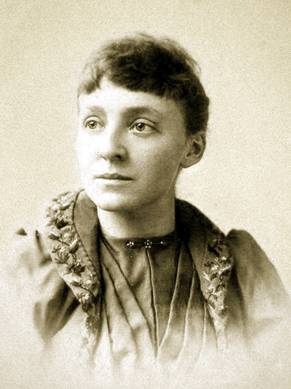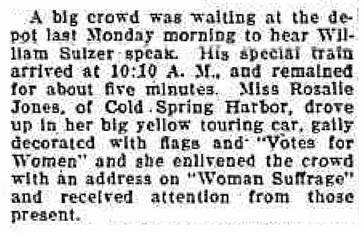Johanna Augustin Taliaferro
Pssssst! Don't worry; you can give your tongue a break. The surname Taliaferro is generally pronounced Tolliver (see the Appendix to this article).
Johanna Augustin Taliaferro
July 26, 1872 - June 14, 1964
"digitally restored" versions of online images found in the
Hicksville Public Library Collection at nyheritage.org

She was the first daughter of Frederick Julius Augustin, one of the early German settlers of Hicksville who rose to prominence. He was a man who went quickly from one success to the next. He published a newspaper in German for his fellow immigrants, but left it for a new challenge: establishing a thriving retail business. He sold the business once the challenge was gone, and decided to retire young. His concept of retirement did not differ substantially from what we would consider working. He settled into an impressive home, and soon added a retail lumberyard and coal yard to the property. He remained active in church and fraternal activities, and he also served as a TOBAY Justice of the Peace.
In the picture of the young Johanna, above, she reminds one of her father, as seen in a portrait in the Evers' book on Hicksville. She too looks thoughtful, accepting rather than determined, and not at all carefree. That's understandable. Her young mother, Johanna Freytag Augustin, had died four days after giving birth to Johanna. Julius must have done everything in his power to get his wife the best medical attention, for she died in Manhattan, probably in a hospital. New York City records say that she was only eighteen.
Like her mother, Johanna Augustin married at seventeen. Her husband, Dr. Fontaine Newton Taliaferro, had been born in Virginia; he practiced in Hicksville and served as Coroner. A son was born four years after they married, and given his father's name. Fontaine Sr. became ill and died nine months after becoming a father. The following year, the new widow's father Julius, fifty-seven years old, died after a struggle with kidney disease. Johanna moved in with her grandmother Freytag. She would never remarry.
*
By the time the renaissance of women's suffrage activity was reaching its height, Johanna Taliaferro had become an officer of Plainlawn Cemetery, had lost a bid to be elected to the School Board (perhaps because Hicksville did not elect women to the School Board in those years), had become a founding member of the first Rebekah Lodge (part of the Foresters organization) in Nassau County, had donated a new bell to the Methodist Episcopal Church, and was developing or selling idle properties that had belonged to her grandmother. Part of the latter effort included her becoming proprietor of the Kenmore Hotel on West Marie Street. She pleased Hicksville's townsfolk by having cement sidewalks poured from Broadway to Jerusalem Avenue on the north side of Marie Street.
Clearly, this was the kind of woman whom the movement had wanted to recruit.
*
On August 23, 1912, Teddy Roosevelt's Progressive Party - aka the Bull Moose Party - held a "mass meeting" in Hicksville's Grand Central Hotel. On the agenda was an address by a government official, who explained the legal issues to be faced by efforts to establish women's suffrage in New York State. This was not surprising - at the party's recent convention, some "upstarts" had succeeded in revising the party platform to be in favor women's suffrage.
The following month, the largest Mineola Fair to date was held. Yellow, the color adopted by the suffragist movement, was much in evidence - there were yellow banners, yellow placards, and even yellow cars owned by "suffragettes." Johanna Taliaferro was there, working the crowds along with dozens of other women, signing up supporters.
On the eve of the November election, William Sulzer, Democratic (and soon-to-be-victorious) candidate for Governor, arrived in Hicksville by train, and made a brief last-ditch speech, presumably from the open platform of an observation car. An uninvited suffragist deliberately drove up at the same time to poach the crowd, addressing it from her yellow touring car.

Huntington Long-Islander, November 8, 1912
The next day, however, the voters again did not choose to grant New York women suffrage. Part of the difficulty lay with the simultaneous promotion of Prohibition by women; men who otherwise might have considered supporting women's suffrage feared that, if allowed to vote, most women would be pro-temperance.
***

